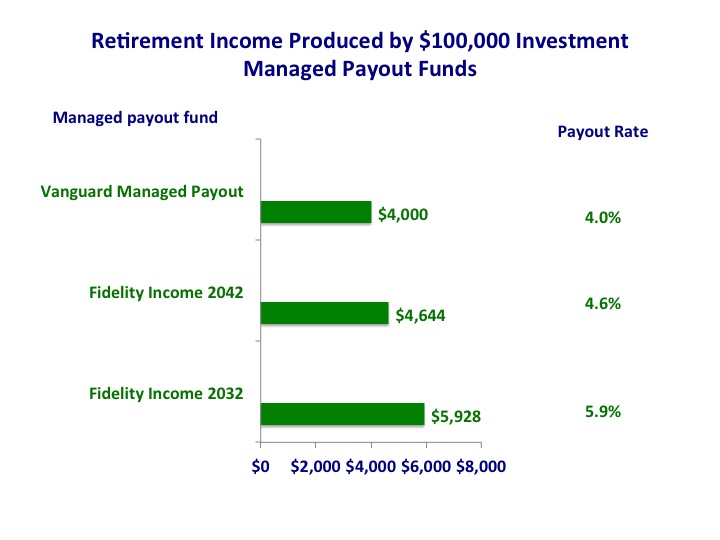Understanding how "systematic withdrawals" affect retirement
Continuing our look at how to assess
your future retirement income, let's turn our attention to "systematic
withdrawals," which are one of three ways to generate a paycheck from
the retirement savings you've stashed away. (For more background on the
three methods, you may want to review my recent post on that topic.)
Financial planners and writers will often tell you something along these lines: If you invest in a portfolio balanced between stocks and bonds, withdraw four percent each year for retirement income and give yourself an annual raise to account for inflation, there's a roughly 90 percent chance that your money will last for at least 30 years. Hence, the justification for the so-called four percent rule.
The four percent rule is actually a good starting point for considering an appropriate withdrawal rate. But if you fall into one of the following two categories, you might want to consider withdrawing amounts of less than four percent:
- If your retirement investments are actively managed and incur investment expenses of more than 50 basis points (0.50 percent), over the long run you may fall short of the net rates of return that justify the four percent rule.
- If you're married, both you and your spouse are healthy, and you retire in your early to mid sixties, there's a good chance that one of you will live for more than 30 years.
If either of these statements applies to you, you may want to consider payout rates on your retirement income of three or three and a half percent.
In addition, there's a point of view emerging from some financial analysts, such as Dr. Wade Pfau, that the analyses supporting the four percent rule are based on a period of U.S. history that may have been a remarkably good time for stock and bond returns. It may be that future returns on stocks and bonds won't be able to support a four percent withdrawal rate. If you believe this, you may want to use a lower withdrawal rate.
In spite of the above thoughts, you might consider a higher withdrawal rate if you're willing to accept some chance of running out of money before you die, or if you're willing to curb your withdrawals down the road if your investments sour. In short, setting the appropriate withdrawal rate is both art and science, and there's no single "right" answer that works for everybody.
Here's the simple table comparing these payout amounts and rates for $100,000 in retirement savings. You can use this table for comparing the amount of retirement income to RIG #1, interest and dividends.
Now let's look at managed payout funds offered by mutual fund companies. Fidelity offers their so-called income replacement funds, which invest in portfolios balanced between stocks, bonds, and cash, and pay a monthly retirement income that includes interest, dividends and principal payments. The Fidelity funds are intended to be exhausted at their target date (thus the snarky nickname for this investment, "target death funds"). The asset allocation to stocks for a specific fund decreases as the fund nears its exhaustion date.
Until recently Vanguard has offered three managed payout funds, each having different asset allocations and payout rates. Vanguard recently announced that in early January, 2014, it will merge the three managed payout funds into one fund, called the Vanguard Managed Payout Fund. This merged fund will have an annual payout rate of four percent. It will invest in a broadly diversified selection of investments, including other Vanguard funds, stocks, REITs, bonds, cash, inflation-linked investments, and selected other investments.Here's a comparison of the annual retirement paycheck produced by the
Fidelity and Vanguard funds and their payout rates as of January 2014.
The Fidelity 2032 fund is intended to last 19 years, and the Fidelity 2042 fund is intended to last 29 years. The Vanguard fund is intended to last indefinitely, although there's no guarantee that your investment will last for the rest of your life. My recent post elaborates on the odds of failure for various systematic withdrawal strategies, and you can use it to assess the viability of the Fidelity and Vanguard funds.
The payouts from the Fidelity funds are generally higher than those from the simple managed payout rules shown previously. Why? A few reasons:
- With the simple managed payout rule, your monthly income is intended never to decrease, even with poor investment returns. You start with a low payout rate to be able to withstand possible future unfavorable investment returns. With the Fidelity income replacement payout funds, your monthly income can decrease in the future if returns head south.
- The Fidelity funds are intended to be exhausted at their target date.
Also note that the Vanguard and Fidelity funds each have different asset allocations, depending on their growth goals, which explains the different payout rates.
Clearly, there are differences in the way systematic withdrawals can work, and you'll need to spend some time learning about the different strategies and features. Don't simply pick the method or fund that generates the highest retirement income. And recognize that systematic withdrawals require the most ongoing attention of the three different ways to generate retirement income.
The retirement income data in the charts above represent pre-tax income amounts. So it's important to recognize that federal and state income taxes will have a significant effect on your after-tax income and should be taken into account. The income taxes you pay will vary depending on whether your retirement savings have previously been invested before taxes in traditional IRA or 401(k) accounts or have been invested after taxes, such as in a Roth IRA. Your eligibility for special tax treatment on capital gains, ordinary dividends, or municipal bonds will also come into play.
Stay tuned for my next post that shows the retirement income scorecard for RIG #3, immediate annuities.


